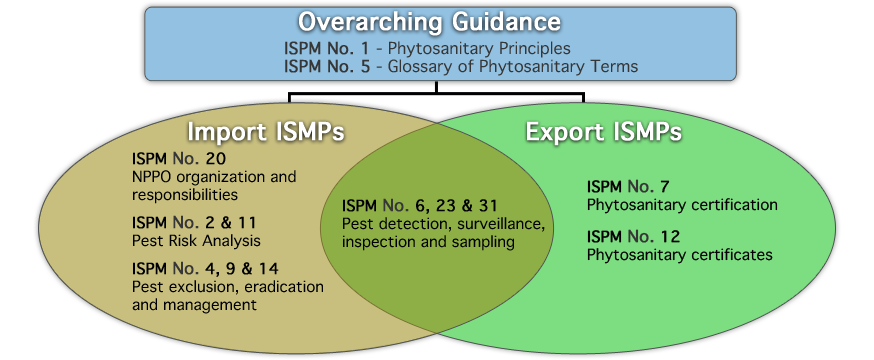Lesson 6: ISPMs and the NPPO
Topic 1: Overarching Definitions and Principles
ISPMs that provide broad principles and guidance lay the foundation for setting up a strong phytosanitary program. ISPM 1 outlines the fundamental principles of plant-heath measures, while ISPM 5 provides a glossary of the many terms used throughout the IPPC and other ISPMs.
Objectives:
- Describe the basic and operational principles for national phytosanitary systems (ISPM 1)
- Describe important phytosanitary concepts (ISPM 5)
In previous lessons, we discussed what standards are and how they are developed. For plant-health practitioners, an additional, and perhaps even more important consideration, is how the guidance found in ISPMs affects a plant-protection organization’s day-to-day operations. Not only do ISPMs provide broad guidance to NPPOs regarding principles and responsibilities, they also provide specific guidance to NPPOs regarding administrative and analytical procedures, domestic safeguarding, and phytosanitary import and export operations. In this lesson, we summarize a selected group of ISPMs that are relevant to the organization and basic responsibilities of an NPPO. Some, but not all, of these ISPMs are covered in more detail in subsequent modules.

As you can see in the diagram above, ISPMs related to pest detection are relevant for both import and export operations. Note that this list does not include all 36 ISPMs, and that the ISPMs could be grouped differently, depending on desired emphasis.

ISPM 1: Phytosanitary Principles for the Protection of Plants and the Application of Phytosanitary Measures in International Trade
Purpose of Standard:
The purpose of ISPM 1 is to provide guidance on the principles that are fundamental to a phytosanitary system.
Summary of Standard:
ISPM 1 identifies basic principles related to the rights and obligations of contracting parties to the IPPC. These principles include:
- Sovereignty
- Phytosanitary necessity
- Managed risk
- Minimal impact
- Transparency
- Harmonization
- Non-discrimination
- Technical justification
- Cooperation
- Equivalence of measures
- Modification
Operational principles related to the implementation of measures and to the administration of national phytosanitary systems include:
- Pest risk analysis
- Host pest list
- Recognition of pest-free areas
- Official control for regulated pests
- Systems approaches
- Surveillance
- Pest reporting
- Phytosanitary certification
- Phytosanitary security and integrity of consignments
- Prompt action
- Emergency measures
- Dispute settlement
- Notification of non-compliance
- Information exchange
- Technical assistance
- Provision of a national plant protection organization (NPPO)
ISPM 5: Glossary of Phytosanitary Terms
Purpose of Standard:
The purpose of this reference standard is to increase the clearness and uniformity in the use and understanding of terms and definitions used by contracting parties for official phytosanitary purposes.
Summary of Standard:
The glossary is revised annually to add new terms and to delete outdated or inconsistent terms. This ISPM is a fundamental resource that all plant-health practitioners should be familiar with. Many glossary terms have already been defined in the text of this module. Several important definitions that deserve emphasis include:
- Harmonization
- Official control
- Pest-risk analysis (agreed interpretation)
- Pest-risk management (for quarantine pests)
- Phytosanitary certificate
- Phytosanitary measure (agreed interpretation)
- Quarantine pest
ISPMs 1 and 5 provide broad guidance on phytosanitary principles and definitions to NPPOs.
To continue, select Topic 2 from the Topics menu above or click here.